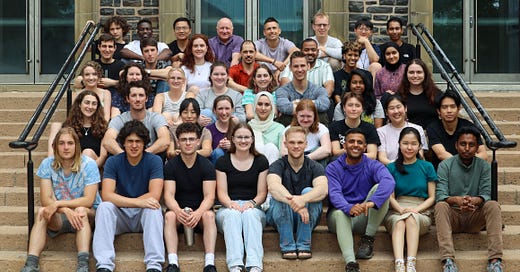In Halifax the Future is Salty
As cutting edge battery development ramps up in Halifax labs, the future of energy storage looks bright—and tastes salty.
When Jeff Dahn brought his battery lab to Halifax we got something amazing.
Now riffing on that, we're drawing in more investment, more federal money, and more talent.
A quick add of the running total looks like they’ve brought nearly $100m to Halifax in the last 10 years. And they are just getting started.
Get a quick tour inside Halifax’s Tesla-funded battery research lab.
It shows the power of ideas and creativity to create wealth.
Forget about electric cars as they now are. Better batteries will change the future such that we’ll laugh about that weird sideroad. Once we have really amazing batteries - batteries that are light, cheap, high capacity, environmentally friendly, long-lasting, and you know… actually hold a charge - we can do so much more
Sodium Ion batteries are on the way to solving many battery problems and many of the world's problems and Halifax labs are leading the way to a better future.
Here’s what you need to know
There are naysayers of course. The battery business is high stakes, with a longer crazier history than most folks imagine. But when breakthroughs come it’s big news.
Sodium-Ion Batteries: The Next Big Thing in Energy Storage
Imagine a world where your phone, electric car, and even the electricity in your home are powered by a technology that's as common as table salt. That's the promise of sodium-ion batteries, the latest buzz in the world of energy storage. Let's break down why these batteries are so exciting and what makes them potentially game-changing.
What Are Sodium-Ion Batteries?
At their core, sodium-ion batteries work similarly to the lithium-ion batteries we're all familiar with. Both types of batteries store and release energy through the movement of ions between two electrodes—one positive (cathode) and one negative (anode). The big difference is that sodium-ion batteries use sodium ions instead of lithium ions. And guess what? Sodium is a whole lot cheaper and more abundant than lithium because it's derived from salt.
Why Are They Great?
1. Abundance and Cost: Sodium is the sixth most abundant element on Earth, found everywhere from oceans to table salt. This means sodium-ion batteries could be cheaper to produce and less dependent on the supply chain issues that plague lithium-ion batteries. Imagine not having to worry about rare minerals from far-off places.
2. Environmental Friendliness: Mining lithium has significant environmental impacts. In contrast, sodium is more environmentally friendly to extract, and using it reduces the need for resource-intensive mining.
3. Safety: Sodium-ion batteries are less likely to overheat and catch fire compared to their lithium counterparts. This makes them a safer option for many applications.
The Exciting Developments
1. Improved Performance: Recent advancements in sodium-ion technology are closing the performance gap with lithium-ion batteries. Scientists are finding ways to make sodium-ion batteries store more energy and last longer, which is crucial for things like electric vehicles and renewable energy storage.
2. Rapid Charging: Innovations are also making sodium-ion batteries faster to charge. Imagine charging your electric car in the same amount of time it takes to fill up with gas.
3. Commercial Viability: Companies and researchers are pushing sodium-ion batteries out of the lab and into real-world applications. This means we could see them in products like smartphones, laptops, and electric vehicles sooner than we might think.
The Road Ahead
While sodium-ion batteries are not yet ready to completely replace lithium-ion batteries, their potential is enormous. The technology is advancing quickly, and with continued research and investment, sodium-ion batteries could become a major player in the energy storage market.
In summary, sodium-ion batteries offer a promising, cost-effective, and environmentally friendly alternative to current battery technology. As development ramps up, the future of energy storage looks bright—and possibly a little salty.






It sounds almost to good to be true. I was aware that this research was moving along but did not know it could be coming so quickly.... good news.